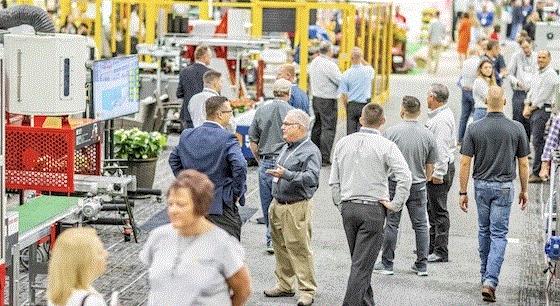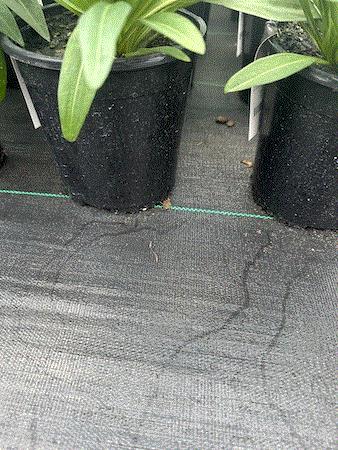What’s Happening Here?
Have you ever walked by a problem and didn’t even see it was there? The human eyes are trained to only see the obvious or things they're specifically looking for. The eyes and brain tend to tune out sometimes very obvious cues. This is the topic of this week’s diagnostic challenge. Take a look at the following image:
I was in a greenhouse recently walking rather quickly from one crop to the next while working on a non-cultural component of perennial production. At first, I walked right by the area shown in the image above. But then out of the corner of my eye I noticed something that was out of place. Have you seen this before? Whether you previously witnessed it or this is unfamiliar to you, could you please tell me “What’s happening here?”
I’ll reveal the answer at the end of the newsletter. Take your time and enjoy the upcoming content ...
Cultivate‘23
I can’t believe it’s already July and Cultivate’23 begins this weekend. If you’ve attended Cultivate in the past, you already know what a great opportunity it is to see what’s new, attend educational sessions and to network. If you’ve never attended, what are you waiting for?
Cultivate is one of the industry’s top events, attracts over 10,000 attendees each year and has something for everybody.
Cultivate’23 has an expansive trade show covering over 8 acres of space and is occupied by over 650 trade show exhibitors. There are more than 160 educational sessions, numerous workshops, several tours, a large new varieties showcase and much more.
Cultivate’23 begins this weekend (July 15-18, 2023) at the Columbus Convention Center in Columbus, Ohio. I hope you can make it.
Click
HERE to learn more about it.
PPA’s 2023 National Symposium

Be sure to check out the upcoming
Perennial Plant Association’s 2023 National Symposium in Niagara Falls, Ontario, on July 24-28, 2023. Set on the Canadian side of Niagara Falls, the symposium promises to be the ultimate gathering for perennial plant enthusiasts featuring an array of exciting tours, educational sessions and networking opportunities.
Various Tour Highlights
-
Landscape Ontario Trial Gardens
-
NVK Nurseries
-
Royal Botanical Gardens
-
Sheridan Nurseries
-
Vineland Research & Innovation Centre
And there are so many more tour destinations than those listed above!
Noteworthy Educational Sessions
-
Beth Edney, Designs by the Yard—What Makes an Inspiring Design
-
Brandon George, University of Kentucky—Perennial Plant Sociability Metrics
-
Dr. Allan Armitage, Perennial Guru—The Road That Got Us Here
-
Gary Lewis, Phoenix Perennials—The Complete Talk on Groundcovers
-
Steve Castorani—Native Plant Production Methods Explained
-
Tony Spenser, The New Perennialist—Wildscaping
This is just a sampling of the awesome educational opportunities.
Check out the entire lineup of tours and speakers on the symposium website at

Maximizing Trade Events
Trade shows are excellent opportunities to learn, network and use for planning or getting motivated about future growing and sales seasons. Greenhouse and nursery professionals attend trade events for a variety of reasons. Whether you're looking for new plants or equipment, hoping to gain marketing ideas, learning new production techniques at the educational sessions, or networking with customers or industry peers, there's only a finite amount of time to maximize your experience at each of these events.
I've found it very beneficial to have a game plan before stepping foot into the venue. Figure out what you want to achieve. Your goals could be finding how to correct past production issues, discovering the next hottest new crop, how to improve your retail presence or several other possibilities.
Try to get your hands on the events directory or map of the trade show floor and start planning and prioritizing. Determine which educational events you're going to attend; somehow prioritize them using a simple system, such as "must see" or "would like to attend." I recommend taking the same approach with the trade show exhibitors—determine who do you "have to visit" and who you’d "like to visit."
You’ll quickly learn that there are likely conflicts keeping you from doing everything you would like to do. If you’re by yourself, you'll have to put some thought into how to maximize your time. If you’re attending with coworkers, divide and conquer. Hit the priority sessions or exhibitors first. Once you've accomplished that list, move on to the secondary priorities. If you complete both of your priority lists, then feel free to walk the trade show or attend more educational sessions at your leisure.

Trade Show Pointers

Here are some tips I've found helpful when walking the trade show floor:
-
Schedule some of your “must see” meetings in advance. Don’t leave it to chance that the individual(s) you need to see will be available when you arrive at their booth.
-
Many trade events have apps that are useful in helping you to know when things are happening, how to find them, and often include trade show maps and planners to help you manage your time at the event.
-
Some of the trade events are really large—bring comfortable shoes.
-
Only pick up or accept literature that you need and intend to use. Picking up every piece of literature isn't necessary and can be heavy to lug around for several hours. I've had good intentions so many times when collecting information. However, more often than not, I find the literature sitting in the trade show bags many months and even sometimes years later. Be selective in what you choose to take with you.
-
Don't be intimidated or afraid of approaching the salespeople working the booths at the trade show. Introduce yourself and when someone approaches you, compliment their booth or their product(s). Then ask specific questions, such as "How does your product work?" or "What’s new?"
-
Bring lots of business cards and take them everywhere you go. You can meet an important contact anywhere ... like the elevator, hotel, lobby, restaurants—and even at the bar. You never know, so be prepared.
-
If you don't already have a contact person with the company you have an interest in, be sure to get a business card. It's not enough to only give someone your contact information.
-
Follow up. About a week after the trade show, follow up with the companies you intend to work with. Following up is key to successfully maximizing your new contacts.
Approach these events with both a solid plan of what you intend to get out of the show and an open mind. In most cases, you’ll discover useful nuggets in places you never expected to find them.

Sanguisorba Plum Drops
Here’s a new perennial I’m guessing you haven’t seen before. In fact, I suspect you haven’t even heard of sanguisorba. Before I show you Intrinsic Perennial Gardens recent introduction, please allow me to update you on this promising genus.
Sanguisorba, aka burnet, is an herbaceous perennial belonging to the Rosaceae family. This genus has quietly been gaining awareness with its use in naturistic, prairie-style plantings in recent years. Burnet bears masses of flowers on slender wiry stems atop its decorative pinnate foliage. The flowers are described as being either fluffy and bottlebrush shaped, catkin-like, or small and bobbly with colors ranging from soft pink and white through darker pink to dark maroon.
Plum Drops
Plum Drops is Intrinsic Perennial Garden’s first sanguisorba introduction. The plants have green pinnate foliage and produce loads of finger-shaped, plum-colored flowers atop upright wiry like stems. Flowering begins in August and continues well into October. Plum Drops grows 3- to 4-ft. tall and 2-ft. wide. I haven’t seen any hardiness data, but expect it would be hardy to Zone 4 like other sanguisorba—but don’t hold me to it!

The Answer is …

I shared this image at the top of the newsletter and asked if you could see what I couldn’t. I imagine this may have been easier for you than it was for me in real time. You had one image focusing on the area I wanted you to see, whereas I initially saw a different perspective over a much larger area. Nonetheless, sometimes when diagnosing or discovering problems, the clues are right in front of you.
Let’s step back and look at the bigger picture ...
Does this vantage point help you solidify your answer? Are you a little "sluggish" to come up with a response? Sorry about the pun, but if you answered the lines on the fabric are caused by slugs or snails, you correctly solved the challenge (they were actually snail trails in this case). Here’s confirmation on one of the plants the black trails led to:
I covered snail and slug control options in these past newsletters—please refer to them for management strategies:
It’s totally coincidental that this topic was covered exactly one year apart in each of the past two years—believe me when I say that I’m not that organized to pull off such a feat.



Thanks for reading this edition of Perennial Pulse. My email is paul@opelgrowers.com if you have any comments, article suggestions or if you'd just like to say hello.
Best regards,

Paul Pilon
Editor-at-Large—Perennial Pulse
Director of Growing—Opel Growers
This email was received by you and 34,919 other fine subscribers!
If you're interested in advertising in Perennial Pulse, contact Kim Brown ASAP and she'll hook you up.